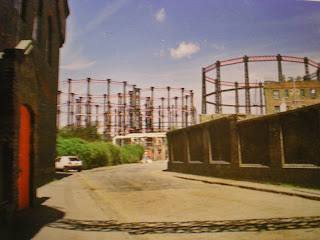THE END OF THE LINE: King's Cross out of joint 6

Kings Cross, the fabled gateway to the city, and the yearned for exit route.
- Savage Messiah
The grand utilitarian hulk of King’s Cross Station was built in 1852, at the height of the Industrial Revolution, on the site of an old smallpox and fever hospital. Alongside the chest-beating St Pancras, King’s Cross looks like it has been trodden on and squashed. Its bricks are an ashen yellow, its arches are less piquant, and it is named after a statue which was so unpopular the authorities pulled it down ten years before the station was opened.
But King’s Cross sums what is wonderful up about this area better than its red-brick rival. You could hardly call it Modernist, but it does follow Modernism’s number one dictum: its form is determined by its function. King’s Cross has no ambitions to be anything else; it is not ashamed to be a mere railway station. The stoical countenance which Cubitt designed for it will be restored when Network Rail removes its flat-roof extension, which British Rail clumsily tacked onto it in the 1970s.

Its untidy, neglected surroundings suit it well – much better than the future that Argent have planned for it. On the whole, this is an area which has managed to elude the big corporations. The Big Issue was set up here. The radical bookshop Housmans is based in Caledonian Road, and is the place to go for more information on King’s Cross (its shelves and its staff provide a wealth of knowledge and curiosity). The NUJ, RMT, NUT, UNISON, Community and UCU all have their headquarters around Euston Road, and civil liberties and campaigning legal practices are scattered around Grays Inn Road. Not only does this suit the radical history of the area (I shall be writing about the St Pancras Rent Strikes soon), it produces a place which people want, and can afford, to live in.


But Argent isn’t interested in community development or local identity. It seeks to maximise income, and the best way to do this is by attracting larger corporations who can afford higher levels of rent. Despite the best efforts of local groups, the gentrification of King’s Cross Central is well underway. The self-contained communities which grew around King’s Cross have already vanished, their streets now mere skeletons.
Stanley Buildings and the Gymnasium - 2000 + 2008


Weller's Court - 2000 + 2008


Looking north from Cheney Street - 2000 + 2008


(BEFORE PHOTOS FROM ANGELA INGLIS'S BOOK RAILWAY LANDS
But never fear! After much umming and ahhing, Argent have worked out what we all want! Cafes! Bars! Restaurants! Water features! As far as the eye can see!

0 Comments:
Post a Comment
<< Home